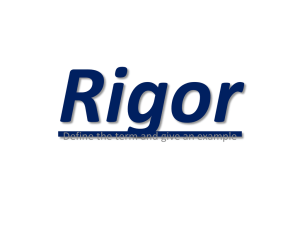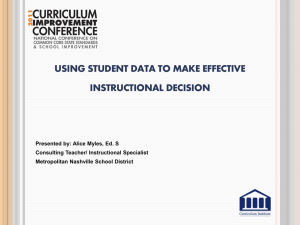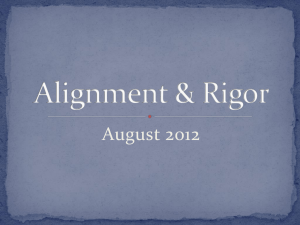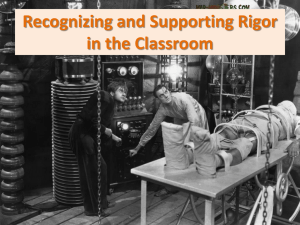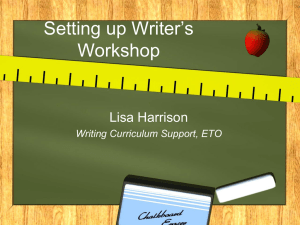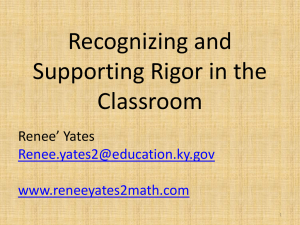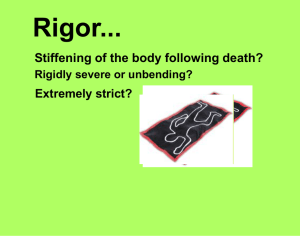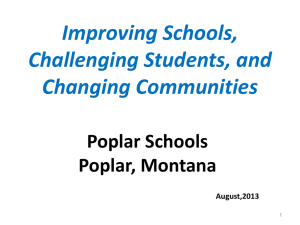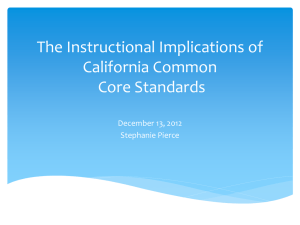Secondary Common Core Power Point with Charlotte Final
advertisement
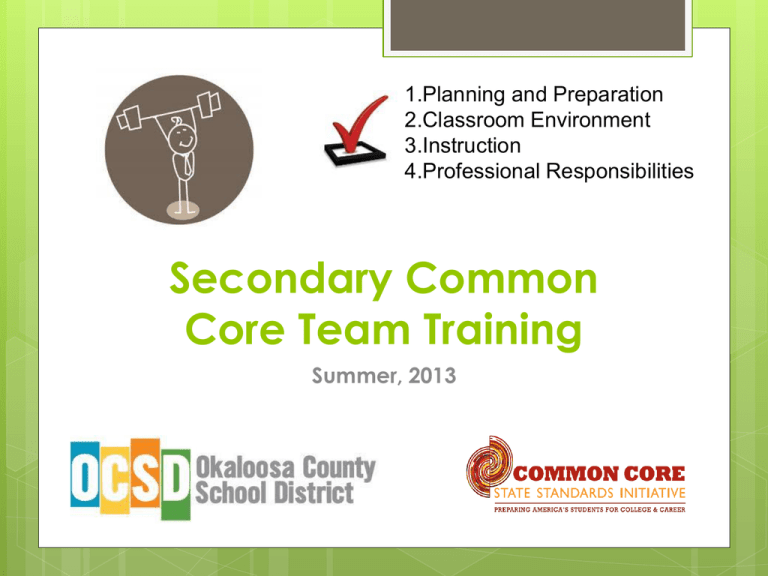
1.Planning and Preparation 2.Classroom Environment 3.Instruction 4.Professional Responsibilities Secondary Common Core Team Training Summer, 2013 Let’s “grapple”! 2. Classroom Environment 1. Create a “Name Tent” – fold large, colored card. Write your name with a marker. School, Grade Level, and What You Hope to Learn 2. FOLD 3. NAME “Implementation!” Learning Goals: Unpack Common Core Standards using the KUD (Know-Understand-Do) method. Identify the components of “rigor” and a Common Core lesson. Locate resources on the Okaloosa County Common Core Website applicable to a specific grade level or content area. Success Criteria: With your Common Core Team, develop an action plan regarding implementation of unpacking Common Core Standards. We’d appreciate it if: There are no “Hogs and Logs” Respect all opinions Cell phones silenced Can you relate??? Everyone needs a superhero! You are OUR superheroes! There’s been a whole lot of learning going on! Math Representatives Will Be Meeting In The Dining Room 3. Instruction What is Rigor? (using a Double Entry Journal) On your Double Entry Journal, consider a personal experience that was “rigorous” and put that experience on the left side in the top box. 2. On the right side, think of the experience. What MADE that experience rigorous? 1. 2. Classroom Environment 3. Instruction Waiting for Superman After watching the video, consider one fact or quote that you found interesting. Write that fact or quote on the Double Entry Journal in the second box. On the right side, explain what that fact or quote tells you about rigor. 1. 2. 3. Instruction A Few Interesting Facts Please stand. 2. Classroom Environment 3. Instruction “Rethinking College Readiness” by David Conley Step One – Chunking the Text 2. Step Two – From your text, list a few facts or quotes in the third box that seem “Chunking!” interesting. 3. Step Three - On the right side, explain what that fact or quote tells you about rigor. 1. What Does It Mean? College Readiness 2. Classroom Environment 3. Instruction What Does It Mean? College Readiness The level of preparation in ELA/Math necessary to enroll and succeed without remediation for an Associate’s or Bachelor’s “No Degree remediation!” -David Conley Director for Educational Policy Research University of Oregon What does it mean to be “rigorous”? It is helpful to remember what rigor is not: Rigor is not a special program or curriculum for select students. We are not talking about students that are part of programs for the gifted. Nor are we discussing students in special magnet schools. Rigor is for ordinary students attending traditional public schools. Rigor is not about severity or hardship. Rigorous classrooms are both warm and challenging. Finally—and most important—rigor is not a measure of the quantity of content to be covered (endless repetition of chemical formulas or lists of vocabulary words). Rather, rigor is a measure of that content's quality. “Rigor!” What does it mean to be “rigorous”? Watch the movie clip from “Lean on Me” and write down what you notice about the teacher’s presentation related to: 1. rigorous content 2. cognitive engagement with support 3. high expectation instruction 4. assessment and demonstration of learning http://www.youtube.com/watch?v=McDo9efGmys 2. Classroom Environment 3. Instruction Definition of “RIGOR” 1.Instruction Claim: When looking for the elements of rigor, there must be a presence of ___________________________, ___________________________, and ___________________________. Support: Evidence: “Synthesis!” Plan learning experiences and instruction Determine acceptable evidence Identify desired results 1a, 1c, 1e, 1f How does Backward Design Facilitate a Common Core Instructional Sequence? Establish Goals Based on Unpacked Standards Create Essential Questions Based on Standards 1a, 1b, 1c, 1e, 1f, 3c, 3d Create Assessments Based on Standards Check to Ensure Assessments Align with Standards Create Learning Plan Aligned to Standards Students Take Assessment Based on Standards 1a, 1c, 1e Why “unpack”??? Standards require a close read and analyze for meaning Standards are rarely taught in isolation Not all standards are equal in rigor 1a, 1c, 1e, 1f KUD… What?? K.U.D.! K- Know U- Understand D- Do 1a, 1c, 1e, 1f “Real life” KUD How do you know a child is ready to ride a bicycle without training wheels? Know Handlebars Pedal(ing) Break(ing) Steer(ing) Do Understand Both hands must be kept on the handlebars in order to steer the bicycle Uses the handlebars to steer the bicycle in a logical direction Now You Try! “Real life” KUD How do you know a teenager is ready to drive a car alone? Know Understand Do What is the Difference Between Know, Understand, and Do? Know • • • • • Facts Vocabulary Definitions Dates Places Understand • • • • • • • 1a, 1c, 1e, 1f I want students to understand that… Essential truths give meaning to topic Purposeful Has transfer power Allows students to investigate content on a variety of levels Enduring value Requires “uncoverage” Do • • • • Start with a verb NOT the whole activity Thinking skills Final outcome based on the standard, NOT an activity Students should grapple with the “UNDERSTAND” goals and how they apply to the “KNOW” goals KUD Template 1a, 1c, 1e, 1f Understand Sort KUD SORT Answers 1a, 1c, 1e, 1f PRIORITY STANDARDS Reading Informational Text 8 4 PRIORITY STANDARDS “Always” in “All Ways” Reading – Literary and Informational 1 – cite textual evidence/draw inferences 4 – determine meanings of words and phrases Writing 4 – clear and consistent writing 5 – writing process 9 – draw evidence to support 10 – range of writing Speaking and Listening 1 – prepare and participate School Teams KUD Standards “Knowing” the steps comes before “Understanding” the outcome Edge’s Computer Lab Explore Common Core web resources to support classroom instruction and lesson design Training Room Explore components of a Common Core lesson Real World Balance of Text Multiple Sources Close reading Vocabulary study Writing with evidence Purposeful discussion Students encounter complex text with appropriate scaffold and support 1a, 1b, 1c, 1d, 1e, 1f Components of a Common Core Lesson or Instructional Sequence What Instruction is Needed Before Students are Ready for an RST? As a team…. 1. 2. Analyze the middle school and/or high school RST task provided. Using the instructional materials provided and your knowledge of the components of a Common Core lesson, develop a plan to get students ready to tackle this RST. *What types of lessons using the materials provided would be needed? *How would you construct close read lessons using these materials so they begin to “think like a scientist”? *What anchor charts/graphic organizers might needed? 1a, 1b, 1c, 1d, 1e, 1f Research Simulation Task (RST) VOTE YES! VOTE NO! 1a, 1b, 1c, 1d, 1e, 1f Research Simulation Task (RST) 1a, 1b, 1c, 1d, 1e, 1f RST Debrief Partner up with another Common Core Team. Share your learning tasks. Provide specific feedback on lessons. 1a, 1b, 1c, 1d, 1e, 1f, 4a CCSS Website Sum It Up and Strategize As a School Team… -Debrief on your individual “take-aways” from today -Strategize on next steps needed -Complete School Reflection Pass 4d

